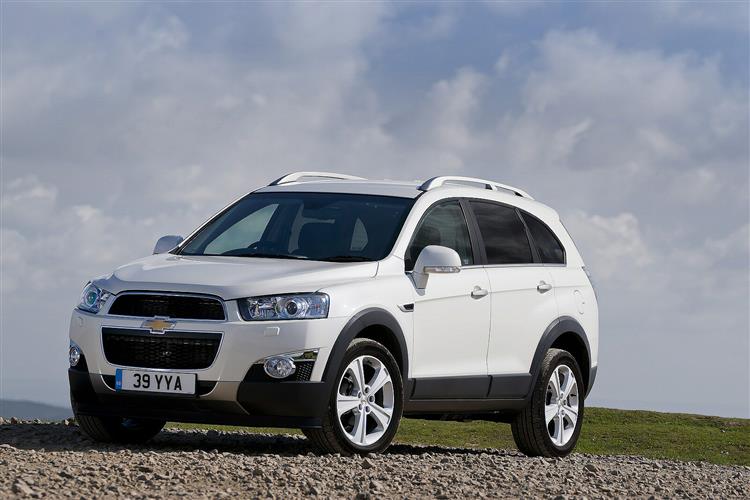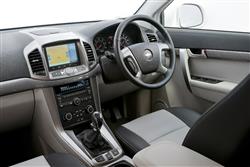This is a sample, showing 30 seconds of each section.
CAPTIVATING? (some text hidden) SECTIONED_new_chevroletcaptiva_2011
By Jonathan Crouch
Introductionword count: 63
Already established as a solid and popular option at the budget end of the compact seven seat SUV market, this improved post-2011 version of Chevrolet's first generation Captiva offered a pokier, more efficient engine range and added a little more attitude and quality to the mix. The changes made this car a far more complete contender. Is it a good used buy though?
Modelsword count: 5
(5dr SUV - 2.2TD 163bhp/18bhp)
Historyword count: 292
Chevrolet is a car maker synonymous with SUV motoring. But the kind of big, beefy truck-like 4x4s and pick-ups the marque is famous for are made for Kansas rather than Kingston. Which was why when the brand re-launched itself in Britain back in 2005, almost its first priority was to bring us an SUV more in keeping with European sensibilities, thinking which brought us the Captiva, launched in 2007. Though its badge might have been American, nothing else about this Korean-built model was. Instead, we got a Far Eastern confection that was pretty much like most affordable Far Eastern family cars: well packaged and well equipped but a bit plasticky inside with a rather noisy diesel engine. With higher quality, a more efficient engine range and a bit of Chevy character, it could have been very good. Back in 2011, Chevrolet reckoned it still could be, re-launching the car with some significant updates. Unlike its Vauxhall Antara sister car, most variants of this improved Captiva continued to offer the seven-seat capacity that most family SUV buyers now want. The original version was the most affordable such vehicle it was possible to buy in the UK market but in revised form, this model's aspirations lay above bargain basement pricing. Justifying the slight shift upmarket was the replacement of the pre-facelift model's rumbly old 150PS 2.0-litre diesel with a couple of pokier, more refined 2.2-litre diesel units, developing either 163 or 184PS. The suspension was revised too, plus there was a plusher, better-equipped interior and a good-looking proper Americana Chevy-style front end that made the old version look very dowdy indeed. It was enough to keep sales ticking over until the Chevy brand was withdrawn from the UK market at the end of 2015.
What You Getword count: 455
The styling of the original Captiva was neat, but rather anonymous. It didn't make a very powerful statement. But this car does. Its raked profile and forward-diving shoulder line work well with an aggressively styled and utterly huge double height front grille only beaten in vertical magnitude by the Eiger. It won't be for the shrinking violets among you but it can make the aesthetics of rival SUVs look faintly apologetic. And inside? Well the airy and spacious cabin still isn't the classiest in the segment from this era, but with this revised model, it had come on a good way from the spacious but low key interior of the original version. The instruments feature signature Chevrolet ice-blue backlighting with everything being easy to read and falling neatly to hand. Apart from trim detail improvements which involved liberal use of soft-touch plastics and metallic trim inserts, probably the biggest change was the deletion of the old conventional handbrake with a slightly fiddly electronic parking brake button. This in turn freed up space for a deep centre cubby box between the front seats which added to the oddments space already provided by the deep doorbins, the huge glovebox and the various cupholders. It's easy to find a comfortable driving position too, thanks to plenty of adjustment through both seat and steering wheel. In the second seating row, both head and shoulder room are adequate and though you can't improve legroom by sliding the seat base back and forth, you can recline the backrest for greater comfort on longer journeys. Behind, there's a couple of occasional seats that fold out from the boot floor - though you have to take the parcel shelf out if you're to use them. Once you've done this, these chairs are relatively easy to access but, as with the original Captiva, their cushion height is so close to the deck that they're really only suitable for kids or adults on very short journeys. As for luggage space, it's predictably mean at 97-litres with all seven seats occupied, though the separately-opening rear window is a neat touch, meaning that you don't need to lug up the rear tailgate if all you want to do is to throw in a sportsbag. If you do need space for bigger items, you'll find up to 769-litres of fresh air is on offer when, more typically, you're not using the occasional third row of seats. And the five-seat version that doesn't have them adds to that further with an additional storage compartment under the boot floor. If you're able to fold the 50:50 split-folding second row of seating down as well to create a completely flat loadfloor, then you'll increase your luggage capacity to a useful 1,577-litres.
To see the full road test text contact us on 0330 0020 227
Pictures (high res disabled)

.jpg)
|
.jpg)
|
.jpg)
| |||
.jpg)
|
.jpg)
|
.jpg)
| |||

|
Scoring (subset of scores)
Category: Crossover or SUV 4x4s
| Performance | |
| Handling | |
| Comfort | |
| Space | |
| Styling, Build, Value, Equipment, Depreciation, Handling, Insurance and Total scores are available with our full data feed. | |



